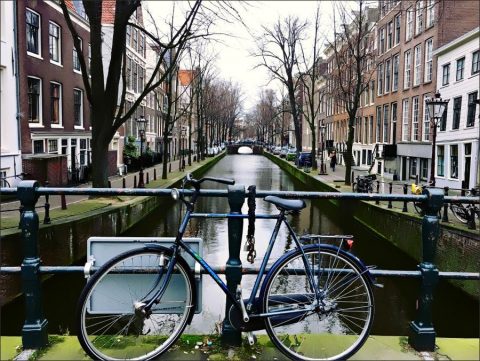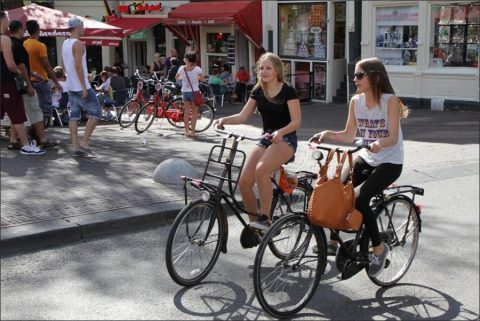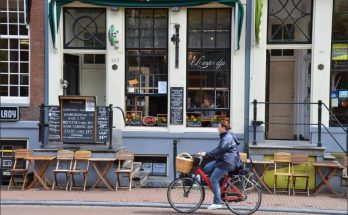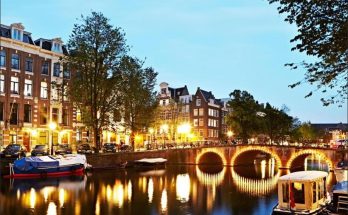Nearly all Amsterdammers–from children to grandparents; messengers to executives; and preppies to punks–ride bicycles. Out of about 730,000 inhabitants, nearly 600,000 own bicycles. About 40 percent of all traffic is from bikes. The city even has a bike coordinator. This proliferation and the culture it creates typify Amsterdam’s laid-back, practical response to life.
Bicycles were introduced in the nineteenth century, as in most of western Europe, but what allowed them to become so popular here is more deeply ingrained. Amsterdam is built on landfill in the IJsselmeer river network. It is therefore laced with canals and extremely flat, ideal for biking. Amsterdam is also a dense city, both physically and in terms of the population, as attested to by the housing crunch of the late twentieth century. The buildings are packed close together around tight courtyards and ribbon-thin streets, on which cars are anathema. According to the Amsterdam tourist board, “Finding a parking spot in the middle of the seventeenth-century city center is no easy chore. The streets in the city are simply not meant for the tens of thousands of vehicles.”
While the bicycle’s popularity decreased with the advent of the automobile, it soon resumed its previous stature in Amsterdam, as in the rest of the country. In her famous diary, during the Holocaust, Anne Frank includes having to give up bicycles in her list of how the situation was worsening for Amsterdam’s Jews under the Nazis.
In the 1960s a group of young liberals calling themselves Provos (Provocateurs) won a surprising seat on the city council for member Bernard de Vries, although they considered themselves anarchists. Among their offbeat policies was a system called the White Bicycle. The city would provide free bikes around town for public use, identified by their white paint. Unfortunately, the plan dissolved when thieves began repainting and reselling the bikes. Today, a similar plan called the depot bicycle is carried out by the private Municipal Transport Company.
Though it did not work out as imagined, the very failure of the Provo plan shows how valued bikes are. To showcase them, Amsterdammers hold a number of events. On September 24, 2000, the city enacted “Carfree Sunday.” May 12, 2001, will be both National Bicycling Day and National Windmill Day. Brigitta, my guide through the Netherlands, enjoys having these days together “because you can take a bike ride by a windmill,” many of which operate only for this occasion. “I took a group on such an excursion once, and it was a great combination,” she says enthusiastically.
Wacky wheels
As testament to the bicycle’s logistical importance, the city houses 140 cycle shops and 25 guarded cycle sheds. At the biggest one, Central Station’s Take a Bike, cyclists ride in and hand off their bikes to attendants, who also work as mechanics. Those who use the shed more frequently have a demarcated spot and handle the interchange on their own. As at other parking garages, they can pay by the day, week, or month at 1.9 guilders per day. In addition to the underground shed, there are outside racks, which hold thousands of bikes under guard.
Amsterdammers are so enamored of cycling that even the most eclectic bikes have a place here. American artist Eric Staaler built the conference bike in the United States, where he was designing what he calls urban UFOs, spacey-looking modes of transport. He was inspired to reconceive his project once he moved to Amsterdam. The bike has three wheels and holds eight people, who all face toward each other, away from the street. One person has a steering wheel, which manipulates the front wheel, beneath the person opposite. Staaler originally meant the unique bicycle as art alone, but finding Amsterdam to be the “great bicycling capital of the world” convinced him that there it could be “a very practical bike, not just funny to look at.” Realizing he could put his invention to use, he began selling the bikes for others to rent out.
Jeroen Prent, owner of Amsterdaam Actief (Active Amsterdam), a planning firm that concentrates on creative approaches to business events, owns one of Staaler’s bikes. While it has been employed for lofty purposes by such groups as Peace Caravan Israel, Prent uses it for clients who seek a unique bonding experience while discussing important issues. He says, laughing, “It’s a crazy bike. When you’re riding it, even in Holland, where we know bikes, everyone is watching, not only tourists. This is a possibility to shock them.” Prent also appreciates the complicated mechanics that allow a circular bike to move forward. As good as the conference bike has been for his business, he cautions that it does better in Amsterdam than other cities because of the flat land. “I think this is one of the best cities for bikes,” he explains. “People come to Amsterdam, especially tourists, to ride a bike.”
A populist tradition
Ria Mol, a guide in Edam, includes a bike ride as part of her tour of that town, because she believes bikes “have something to do with the national character.” She says their proliferation in the Netherlands is unique and that people are proud of their bikes. Shop owner William Abens describes this national character, epitomized by Amsterdammers, as practical and serious. He calls them “very hardworking, not people who are making a lot of fun.” When asked about using bikes in the city, Prent says, “well, it’s only functional. I guess we’re especially practical, with a live and let live attitude.”
Amsterdam’s economic and political histories help explain the present- day bike culture. The city has long been known as a place of opportunity and opportunists, a haven of capitalism and democracy. Originally exempt from taxes and monarchy, it attracted entrepreneurs from all walks of life. Concerned more with making money than pedigree, its residents soon became famous for being nonjudgmental as well.
As a land of religious freedom, Holland attracted otherwise persecuted Jews and took a light approach to the Reformation. Although Catholic churches were no longer allowed to be identifiable as such from the streets, attic churches with no outside demarcations were permitted. On’s Lieve Heer op Solder (Our Lord in the Attic), one such church, is now a free museum near Dam Square. Religious practice was never curtailed.
The same attitude is seen in people’s present relation to their history. The Golden Tulip Barbizon Palace owns the St. Olofskapel (St. Olof’s Chapel), which was built in 1440 and named after the Norwegian patron saint of sailors to please then-current trading partners. Remodeled numerous times, it has been used for myriad purposes, including a cheese market from 1935 to 1961. By late last century, however, the once-distinguished building had become a financial and safety hazard for the city. The hotel agreed to purchase it for a guilder in 1990 with the intent of restoring it as a meeting and banquet facility.
By law the hotel had to retain its historic elements, including over six thousand tombstones (the skeletons were reinterred in the city’s North Cemetery), but it wanted to provide a state-of-the-art facility. The seeming dilemma was solved by using high-tech elements to complement the historic, installing central heating below the tombstones, concealing all light and sound provisions beneath the rafters, and turning the carved heads that ring the interior moldings into wall sconces. Annamerieke Graus, senior sales manager, says, “We like to say we have international standards but local flavor. We don’t like to ‘pretend history’ by falsely re-creating historical objects, so we try to use modern design to complement the historical fixtures.”
This same creative approach is seen in bicycle culture. Just as all types of people ride, all types of clothing are worn while riding. During the winter, cyclists bundle into hats and scarves to defeat the wind. In the rain, people simply ride one-handed and hold an open umbrella in the other. I have seen men in suits and bowler hats, women in high heels and even short skirts riding unperturbed by the possibility of being splattered by mud. Parents often pack multiple children on a bike with them, riding older kids on the handlebars. Even full-size trunks are strapped to the front or back of bikes. Some people listen to Walkmans and chat on cell phones as they pedal.
Even before it became known as the hippie capital of Europe in the 1960s, Amsterdam had a reputation for permissiveness. The most striking examples are the famed legalization of “soft” drugs and the red-light district, or simply Prostutiezone, which today has the air of a tourist attraction. Instead of turning controversial issues into problems, the Dutch choose to manage them in the open. Understanding their unique position on these matters, the Dutch, ever practical, have taken measures to guide tourists in their strictly governed usage. “No photography” signs dot the streets of the red-light district, which is adjacent to a neighborhood of fancy hotels, shops, and restaurants. The police have even created a brochure for hotels to place in guest rooms outlining the correct procedures and behaviors concerning these matters, whose straightforwardness Brigitta calls “very Dutch.”
This practical, low-key approach is at the heart of bike riding’s popularity; the rules are more free than for other forms of transportation. My guide in Amsterdam, Nicolette, says that cars follow most rules, tram cars ignore more, and bikers regard the least. Indeed, Amsterdam cyclists have been called “merciless.” The Netherlands is filled with attempts to make bike traffic safer for riders as well as pedestrians and drivers of other vehicles. There are bike traffic lights and more bike paths than in any other country.
Nevertheless, tourists are warned repeatedly to be wary of careless riders zooming up behind them. In fairness, many of these incidents happen to those who mistake bike paths for sidewalks. I once witnessed a troop of Japanese businessmen rolling their suitcases to a swank hotel in the center of the bike path. Chatting casually among themselves and pointing eagerly to their hotel, they were so startled by a speedy young cyclist dinging her bell that they jumped onto the real sidewalk with their suitcases clumping up after them. Prent tells me that “the bike is … related to freedom. Bike riders, especially in Amsterdam, ignore traffic lights, even when there is a police car nearby.”
More than transportation
Many people claim bikes are popular because they are the easiest way around the city, and yet, like Domingo Van Dertak, a parking attendant at Take a Bike, many take the train. He says he is like most of his countrymen, who “have been riding all their lives.” Anthropologists say the most important facets of a society are the ones that people can give no reason for doing but feel are simply part of their makeup as a group. When I probe Prent about this, he answers, “I guess we all ride bikes, just because we do. … We don’t think about it. It’s not a decision we have to make. It’s our heritage. We don’t know any better.”
People claim that Vespas or other small mopeds, which have gained great popularity in other dense European cities, are not used here because they are too expensive. Amsterdammers are not poor, however. Living in the city is considered a luxury because a housing crunch has sent rents sky-high, turning even old slums such as the Jaardin into boom neighborhoods with quaint coffeeshops and kitschy boutiques. Asked if he lives in the city, which he prefers, or the suburbs, Van Dertak exclaims, “Do you know how much the rent is in the center?” There is also a secondary claim to the health benefits of bicycles. Prent, also a phys ed teacher, encourages his students to ride. “Sitting on a moped,” he concludes, “it’s too easy.”
There is, of course, the fear that mopeds will be stolen. Including bike theft, Amsterdam has the fourth-highest crime rate in the world (if bike theft is excluded, it places twenty-fifth). Van Dertak believes that people are proud of their bicycles, pointing out the creative paint jobs that adorn some; they buy inexpensive bikes and neglect maintenance to deter thieves. Nearly everyone rides the same type of balloon-tired “granny” cruiser. There is little variance in price and even less in quality or style.
It is often said that the canals are made of one meter mud, one meter water, and one meter rusting bicycles. Both crooks and legitimate owners dump their used cycles into the canals. Van Dertak tells me that people cannot dispose of them in the trash because the city does not pick up metal. This does not explain why they use the canals, however. In U.S. cities, for instance, many cycles are abandoned at bike racks. Thieves who want to hide stolen bikes might easily paint them, especially since they tend to look so similar, as happened at the downturn of the White Bicycle campaign. Or they could be stripped of salable parts. That they are routinely dumped in the canal suggests a tradition. After all, this is the city that held an Eel Riot in 1886 over a sport that involved a tug-of-war with a live eel.
Allaster, a Canadian journalist touring the Netherlands with me, decides one afternoon to rent a bicycle to better experience the city. He enjoys seeing the buildings, roads, and pedestrians come at him from new angles. “You get a better map of the city,” he says, “because you put all the geography together in your head.” He is nervous about traffic but finds he is able to grasp the bike traffic rules soon after he starts, though the streetcars continue to daunt him. When asked if he feels like a native, Allaster replies, “Not really,” pointing out that he is just minding his business like everyone else. Then he realizes that this makes him seem less like a tourist. He says the bike helped him blend in a little bit but realizes, as Prent and Van Dertak say, he could never fully become part of the bike culture in which “people have been riding all their lives.”






